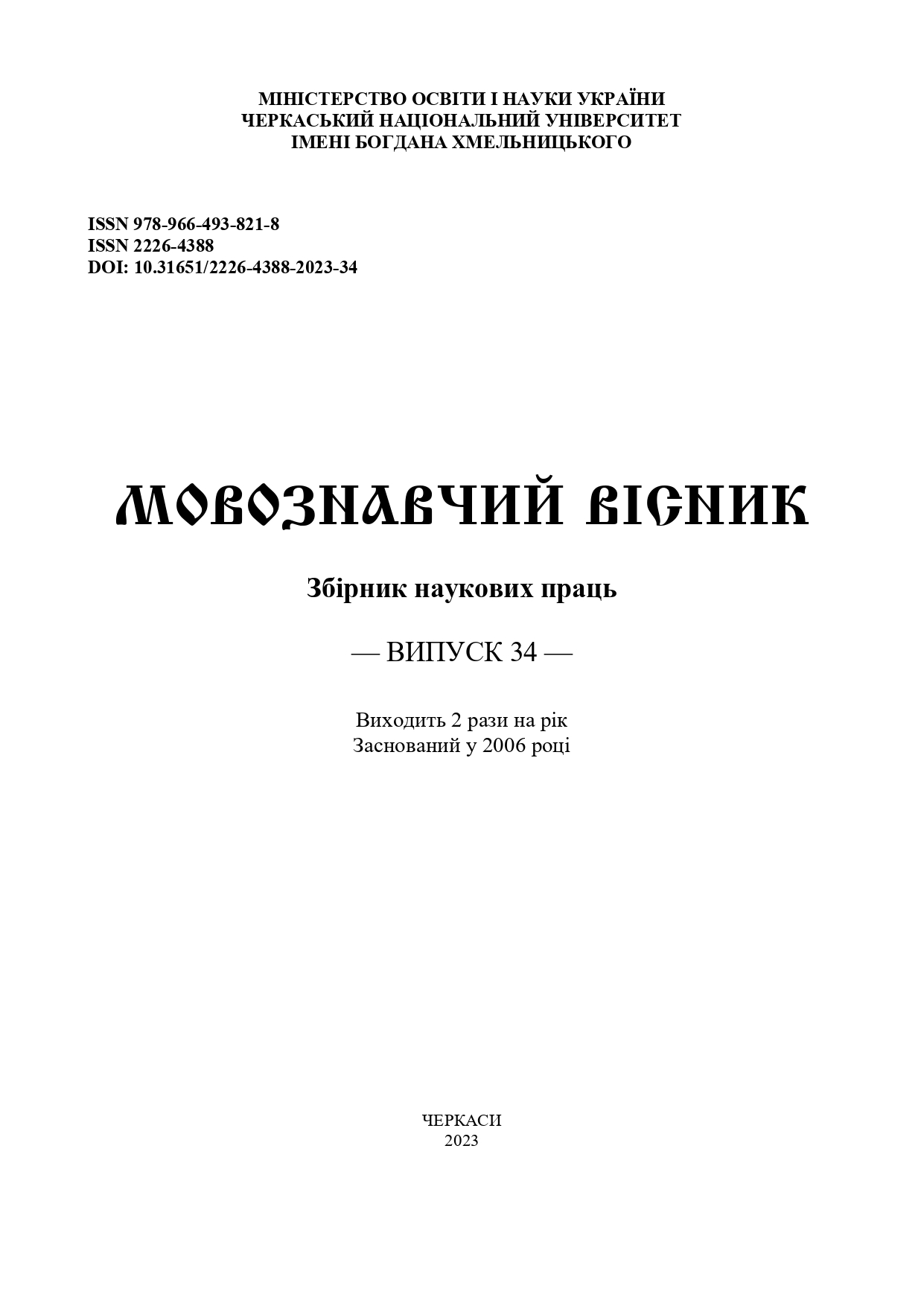MAN-ARTIST IN CONSCIOUSNESS OF NATIVE UKRAINIAN SPEAKERS (ON THE RESULTS OF ASSOCIATIVE EXPERIMENT)
Main Article Content
Abstract
Introduction. Interest in comprehensive exploration of personality has remained strong for a long time. The results of the exploration have been objectified in a significant number of language codes, and one of the most important sources for studying the semantics of units has proved to be associative relations between words. The material for this research has been received as a result of a free associative experiment conducted with university students. The list of stimuli includes high-frequency names of artists in the realm of literature, visual arts, performing arts, and music.
Purpose. The research is aimed at clarification of psychologically relevant relations in the group of artists’ names and their subject, semantic-relevant and functional features, which have been objectified in the speakers’ mental lexicon.
Results. Analysis of associative fields has shown a different ratio of the core and peripheral parts for different stimuli, in which different semantic, thematic-situational, and pragmatic features are explicated. It has been determined that the structure and volume of associative fields were influenced by the following factors: 1) heterogeneous nature of system connections between lexical units depending on the field of art; 2) different amount of semantic information enclosed in language signs; 3) recipients’ level of knowledge of the artists’ specific activities; 4) experience in using the lexemes in speech practice.
Originality. The peculiarity of this research lies in the analysis of associative fields in comparison with lexicographic data. It has enabled the author to distinguish conventional features that form the semantics of the lexemes, and to single out individual features that enrich ideas about the conceptual space and determine the functional potential of names. A significant change in the semantic volume of some stimulus words has been traced, which proves the dynamic nature of the lexical-semantic system.
Conclusion. Analysis of the results of the experiment has shown the predominance of thematic reactions and a high level of subject attribution of stimulus names. The features explicated in associative fields have confirmed a high axiological status of the artist in the Ukrainian language and culture.
Article Details
References
Denysevych, O. V. (2019). Modeli semantychnoi orhanizatsii asotsiatyvnykh poliv reklamnoi leksyky
[Models of semantic organization of associative fields of advertising vocabulary]. In: Naukovi zapysky kafedry
slovianskykh i hermanskykh mov [Scientific Notes of the Department of the Slavic and the Germanic Languages]:
kolektyvna monohrafiia. Novohrad-Volynskyi: NOVOhrad, 266–291 (in Ukr.).
Ivashchenko, V. L. (2006). Kontseptualna reprezentatsiia frahmentiv znannia v naukovo-mystetskii kartyni
svitu (na materiali ukrainskoi mystetstvoznavchoi terminolohii) [Conceptual representation of fragments of knowledge
in the scientific and artistic picture of the world (based on Ukrainian art terminology)]. Kyiv: Vydavnychyi dim Dmytra
Buraho, 328 (in Ukr.).
Zharnotsaiova, Zh. (2020). Metodyka asotsiatyvnoho eksperymentu [Methodics of the associative
experiment]. In: Slavica Slovaca, 55, 1, 69–81 (in Ukr.).
Krylova, M. (2022). Systemna orhanizatsiia nazv liudyny-myttsia v ukrainskii movnii kartyni svitu.
[Systematic organization of human artist names in the Ukrainian linguistic picture of the world]. In: Zbirnyk statei za
materialamy I Vseukrainskoi (NE)klasychnoi studentskoi naukovoi internet-konferentsii «Movno-literaturnyi
kovorkinh» [All-Ukrainian (NON)classical student scientific internet conference «Linguistic and literary coworking»].
Kharkiv: KhNU im. V. N. Karazina, S. 21–25 (in Ukr.). Available at:
http://dspace.univer.kharkov.ua/handle/123456789/17663.
Lozova, N. H. (2016). Ideohrafichna reprezentatsiia kohnitosemnoho prostoru nazv subiektiv kulturnoi
diialnosti v ukrainskii movi [Ideographic representation of the cognite-semantic space of names of subjects of cultural
activity in the Ukrainian language]: Extended abstract of PhD dissertation (Ukrainian language). Lutsk, 18 (in Ukr.).
Lozova, N. H. (2016). Zvedenyi slovnyk nazv subiektiv kulturnoi diialnosti v ukrainskii movi [Consolidated
Dictionary of Names of Subjects of Cultural Activity in the Ukrainian language]. Nizhyn: Lysenko M. M., 239 (in Ukr.).
Martinek, S. (2011). Empirychni y eksperymentalni metody u suchasnii kohnityvnii linhvistytsi [Empirical
and Experimental Methodsin Current Cognitive Linguistics]. In: Visnyk Lvivskoho universytetu. Seriia filolohichna
[Visnyk of the Lviv University. Series Philology], 52, 25–32 (in Ukr.).
Martinek, S. (2007). Ukrainskyi asotsiatyvnyi slovnyk [Ukrainian Associative Dictionary]: u 2 t. Lviv:
Vydavnychyi tsentr LNU imeni Ivana Franka. T. 1: Vid stymulu do reaktsii, 344 (in Ukr.).
Selivanova, O. O. (2008). Suchasna linhvistyka: Napriamy ta problemy. [Modern Linguistics: Directions and
Challenges]. Poltava: Dovkillia-K, 712 (in Ukr.).
Bilodid, I.K. (Ed.) (1970–1980). Slovnyk ukrainskoi movy [Dictionary of the Ukrainian language]: v 11 tt.
Kyiv: Naukova dumka, 1970–1980 (in Ukr.).
Bartmiński, J. (1998). Podstawy lingwistycznych badań nad stereotypem – na przykładzie stereotypu matki
[Fundamentals of Linguistic Research on Stereotype – on Example of the mother’s stereotype]. In: Jezyk a kultura
[Language and culture], 12, 63–83 (in Pol.).
Littlemore, J., Bolognesi, M., Warpakowski, N. J., Leung, Ch.-h. D. & Sobrino, P. P. (2023). Metaphor,
Metonymy, the Body and the Environment. An Exploration of the Factors That Shape Emotion–Colour Associations
and Their Variation across Cultures.Cambridge University Press, 94 (in Eng.).

